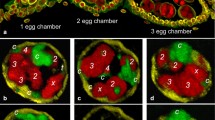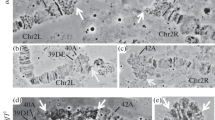Abstract
A comparative study of fluorescence patterns of heterochromatin in mitotic and polytene chromosomes of seven species belonging to 3 subgroups melanogaster sub-group: D. melanogaster and D. simulans; montium sub-group: D. kikkawai and D. jambulina; ananassae sub-group: D. ananassae, D. malerkotliana and D. bipectinata) of the melanogaster species group of Drosophila (Sophophora) has been made. Hoechst 33258 (H) fluorescence patterns of mitotic chromosomes reveal differences correlated to the taxonomic groupings of these species. The melanogaster sub-group species have H-bright regions on heterochromatin of all chromosomes; the montium subgroup species have H-bright regions mainly on the 4th and Y-chromosomes; in the ananassae sub-group, while D. ananassae chromosomes do not show any H-bright regions, D. malerkotliana and D. bipectinata have small H-bright segments only on their 4th chromosomes. The H-and quinacrine mustard (QM) fluorescence patterns of larval salivary gland polytene chromocentre in these species, however, do not show the same taxonomic correlation. While D. ananassae and D. kikkawai polytene nuclei lack any H-or QMbright region in the chromocentre, the remaining species have prominent H-and/or QM-bright region(s). In D. jambulina, the QM-bright regions are generally bigger than H-bright regions, while in D. malerkotliana and D. bipectinata the situation is reversed. Actinomycin D counterstaining prior to H-staining of polytene preparations of each species confirms that the H-bright region/s in the chromocentre are composed of A-T rich sequences. In vivo labelling of salivary gland polytene nuclei with 5-bromodeoxyuridine for 24 to 48 h and subsequent H-staining reveals that in all the species, the H-bright regions do not replicate in 3rd instar stage and presumably represent the non-replicating alpha heterochromatin. Significantly, in all the species (excepting D. kikkawai and D. ananassae), the size, location and the number of H-and/or QM-bright regions were seen to vary in different polytene nuclei in the same gland. It seems that the organization and the extent of under-replication of alpha heterochromatin varies in different polytene nuclei. Present studies also show that even closely related species differ in the content and organization of H-bright heterochromatin. The 81 F band at the base of 3 R in D. melanogaster, but not in D. simulans, appears to contain non-replicating H-bright sequences in addition to replicating chromatin.
Similar content being viewed by others
References
Adkisson, K.P., Perreault, W.J., Gay, H.: Differential fluorescent staining of Drosophila chromosomes with quinacrine mustard. Chromosoma (Berl.) 34, 190–205 (1971)
Baimai, V.: Karyotype variation in D. montium. Dros. Inf. Ser. 44, 115–116 (1969)
Baimai, V.: Cytogenetic studies of certain strains of Drosophila kikkawai. Genetics 74 (Suppl.), 15 (Abstr.) (1974)
Barnes, S.R., Webb, D.A., Dover, G.: The distribution of satellite and main band DNA components in the melanogaster species sub-group of Drosophila. I. Fractionation of DNA in actinomycin D and distamycin A density gradients. Chromosoma (Berl.) 67, 341–363 (1978)
Barr, H.J., Ellison, J.R.: Quinacrine staining of chromosomes and evolutionary studies in Drosophila. Nature (Lond.) 233, 190–191 (1971)
Barr, H.J., Ellison, J.R.: Ectopic pairing of chromosome regions containing chemically similar DNA. Chromosoma (Berl.) 39, 53–61 (1972)
Bock, I.R.: Taxonomy of the Drosophila bipectinata species complex. Univ. Texas Publ. 7103, 273–280 (1971)
Bock, I.R., Wheeler, M.R.: The Drosophila melanogaster species group. Univ. Texas Publ. 7213, 1–102 (1972)
Bridges, C.B.: Salivary chromosome maps. J. Hered. 26, 60–64 (1935)
Clayton, F.E., Wheeler, M.R.: A catalog of Drosophila metaphase chromosome configurations. In: Handbook of genetics (R.C. King, ed.), vol. 3, pp. 471–512. New York: Plenum Press 1975
Comings, D.E.: Mechanisms of chromosome banding. VIII. Hoechst 33258-DNA interactions. Chromosoma (Berl.) 52, 229–243 (1975)
Ellison, J.R., Barr, H.J.: Differences in the quinacrine staining of the chromosomes of a pair of sibling species: Drosophila melanogaster and Drosophila simulans. Chromosoma (Berl.) 34, 424–435 (1971)
Gall, J.G., Cohen, E.H., Polan, M.L.: Repetitive DNA sequences in Drosophila. Chromosoma Berl.) 33, 319–344 (1971)
Gatti, M., Pimpinelli, S., Santini, G.: Characterization of Drosophila heterochromatin. I. Staining nd decondensation with Hoechst 33,258 and quinacrine. Chromosoma (Berl.) 57, 351–375 (1976)
Heitz, E.: Über a-und β-Heterochromatin sowie Konstanz und Bau der Chromomeren bei Drosophila. Biol. Zbl. 54, 588–609 (1934)
Hennig, W.: Highly repetitive DNA sequences in the genome of Drosophila hydei. I. Preferential localization in the X chromosomal heterochromatin. J. molec. Biol. 71, 407–417 (1972a)
Hennig, W.: Highly repetitive DNA sequences in the genome of Drosophila hydei. II. Occurrence in polytene tissue J. molec Biol. 71, 419–431 (1972b)
Hennig, W., Hennig, I., Stein, H.: Repeated sequences in the DNA of Drosophila and their localization in giant chromosomes. Chromosoma (Berl.) 32, 31–63 (1970)
Holmquist, G.: Hoechst 33258 fluorescent staining of Drosophila chromosomes. Chromosoma (Berl.) 49, 333–356 (1975a)
Holmquist, G.: Organization and evolution of Drosophila virilis heterochromatin. Nature (Lond.) 257, 503–506 (1975b)
Jha, A.P., Rahman, S.M.Z.: On crossing between Drosophila bipectinata and Drosophila malerkotliana. Cytologia (Tokyo) 38, 425–436 (1973)
Jorgenson, K.F., Sande, J.H. van de, Lin, C.C.: The use of base pair specific DNA binding gents as affinity labels for the study of mammalian chromosomes. Chromosoma (Berl.) 68, 287–302 (1978)
Kumar, M., Lakhotia, S.C.: Localization of non-replicating heterochromatin in polytene cells of Drosophila nasuta by fluorescence microscopy. Chromosoma (Berl.) 59, 301–305 (1977)
Lakhotia, S.C.: EM autoradiographic studies on polytene nuclei of Drosophila melanogaster. III. Localization of non-replicating chromatin in chromocentre heterochromatin. Chromosoma (Berl.) 46, 144–159 (1974)
Lakhotia, S.C.: Alpha-heterochromatin in related species of Drosophila. Abstr. Cell Biology Conf. (Jan. 9–11, 1978, Delhi Univ., Delhi), 104 (1978)
Lakhotia, S.C., Kumar, M.: Heterochromatin in mitotic chromosomes of Drosophila nasuta. Cytobios 21, 79–89 (1978)
Latt, S.A.: Detection of DNA synthesis in interphase nuclei by fluorescence microscopy. J. Cell Biol. 62, 546–550 (1974)
Lemeunier, F., Dutrillaux, B., Ashburner, M.: Relationships within the melanogaster subgroup species of the genus Drosophila (Sophophora). III. The mitotic chromosomes and quinacrine fluorescent patterns of the polytene chromosomes. Chromosoma (Berl.) 69, 349–361 (1978)
Mayfield, J.E., Ellsion, J.R.: The organization of interphase chromatin in Drosophilidae. The self-adhesion of chromatin containing the same DNA sequences. Chromosoma (Berl.) 52, 37–48 (1975)
Mishra, A.: Effect of low temperature on chromocentre organization in polytene nuclei of Drosophila melanogaster. Abstr. IIIrd All India Cell Biology Conf. (Jan. 10–12, 1979, Cancer Research Inst, Bombay 77 (1979)
Nash, D., Vyse, E.R.: On the polytene morphology of a Drosophila melanogaster chromosomal inversion including the nucleolus organizer. Canad. J. Genet. Cytol., 19, 637–644 (1977)
Patterson, J.T., Stone, W.S.: Evolution in the genus Drosophila. New York: McMillan (1952)
Peacock, W.J., Brutlag, D., Goldring, E., Appels, R., Hinton, C.W., Lindslay, D.L.: The organization of highly repeated DNA sequences in Drosophila melanogaster chromosomes. Cold Spr. Harb. Symp. quant. Biol. 38, 405–416 (1973)
Peacock, W.J., Lohe, A.R., Gerlach, W.L., Dunsmuir, P., Dennis, E.S., Appels, R.: Fine structure and evolution of DNA in heterochromatin. Cold Spr. Harb. Symp. quant. Biol., 42, 1121–1135 (1978)
Pimpinelli, S., Santini, G., Gatti, M.: Characterization of Drosophila heterochromatin. II. C-and N-banding. Chromosoma (Berl.) 57, 377–386 (1976)
Roberts, P.A.: Rapid change of chromomeric and pairing patterns of polytene chromosome tips in D. melanogaster: migration of polytene —nonpolytene transition zone? Genetics 92, 861–878 (1979)
Rudkin, G.T.: The structure and function of heterochromatin. Genetics Toady (Proc. XI Int. Cong. Genetics, The Hague), vol. 2, pp. 359–374. London: Pergamon Press 1965
Schmid, M., Vogel, W., Krone, W.: Attraction between centric heterochromatin of human chromosomes. Cytogenet. Cell Genet 15, 66–80 (1975)
Singh, B.K., Gupta, J.P.: Pattern of chromosomal polymorphism in Drosophila jambulina Parshad and Paika. Jap. J. Genet. 55, 81–90 (1980)
Vosa, G.: The discriminating fluorescence patterns of the chromosomes of Drosophila melanogaster. Chromosoma (Berl.) 31, 446–451 (1970)
Wolff, B.E., Sokoloff, S.: Changes in the form of the polytene X-chromosome in Phryne (Sylvicola) cincta –causes and functional significance. Chromosomes today (Proc. Leiden Chromosome Conf., 1974) vol. 5, 91–108 (1976) New York: John Willey & Sons
Author information
Authors and Affiliations
Rights and permissions
About this article
Cite this article
Lakhotia, S.C., Mishra, A. Fluorescence patterns of heterochromatin in mitotic and polytene chromosomes in seven members of three sub-groups of the melanogaster species group of Drosophila . Chromosoma 81, 137–150 (1980). https://doi.org/10.1007/BF00292428
Received:
Accepted:
Issue Date:
DOI: https://doi.org/10.1007/BF00292428




